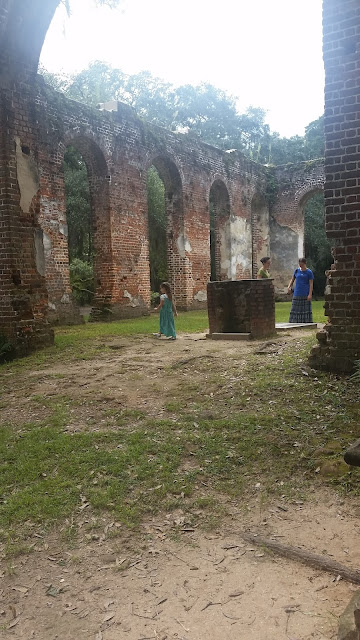The church is outside of Beaufort, SC. It was originally known as Prince William's Parish Church. Built between 1745 and 1753, this church was in a beautiful Greek style. It's building was paid for by Lieutenant Governor William Bull, who had a plantation in the area. The plantation was called Sheldon, and so the church is often referred to by that name as well. Lieutenant Governor Bull attended this church, and is buried on its grounds.
When General Augustine Prevost raided the area during the Revolutionary war, the church was partially burned by local loyalists. The people rebuilt the interior and roof of the church in 1825-1826.
 |
| Inside the Sheldon Church |
 |
| Doesn't it look like a fairytale? |
What remains of the Sheldon Church is extraordinary. I truly wish these beautiful brick walls could talk and tell us of all its history. The Revolution, the marriages, the people, church services, funerals, Civil War, and so much more.
There were many graves that were interesting, including Lt. Gov Bull's, Civil War veterans, and some small children, but there was one in particular that caught my eye and became my favorite. I hope you won't think me grotesque for sharing it with you, because it was just so inspiring.
In case you can't read it, here's what it says:
Until the day breaks and the shadows flee away.
Charles Edward
Eldest son of Rev. Charles E.
Mary Maxcy
Leverett
Born at Beauport, S.C.
January 10, 1833
Died December 21, 1861
Aged 28 years
With the full and animated hope that this mortal would put on immortality through faith in the merits of his Redeemer, Jesus Christ.
Isn't that just the most beautiful thing you've ever seen on a tombstone? This young man was not much older than me when he passed away, probably a victim of the Civil War, but his tombstone inspired me. I would like something similar if I should have to be buried.


I've never had the opportunity to visit any place like that....so cool. Thanks for sharing.
ReplyDeleteSo glad you enjoyed the post, Debbie! There are probably historical places like this around where you live that you could visit on weekends. It's so much fun to learn the history of where you live. :)
DeleteVisiting historical sites makes the history come alive. I have found inspiration in headstones actually.
ReplyDeleteHi Mary,
DeleteI totally agree. I love visiting the sites. I'm glad I'm not the only one who loves to wander around and read the headstones.
Love the post thanks.
ReplyDeleteHi Kim! Thanks for stopping by! So glad you enjoyed it.
DeleteAmber, thank you for sharing your visit and the special inscription on that young man's monument. Our local cemetery has some really old tombstones and I enjoy reading the names and dates. I have found that the older ones often tell the cause of death and many died in a cholera epidemic that struck our area.
ReplyDeleteBlessings!
Connie